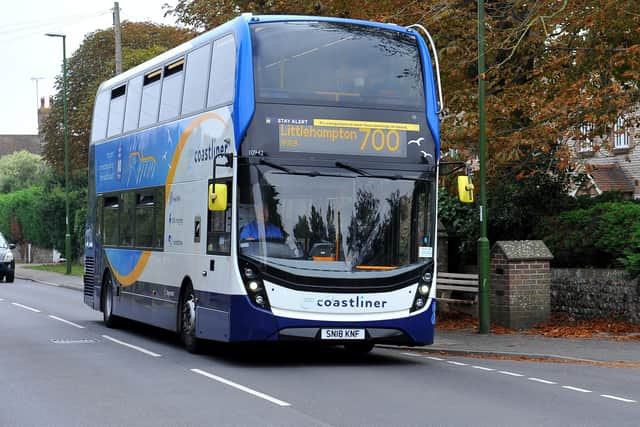Here are the major improvements to bus services in West Sussex being proposed
and live on Freeview channel 276
Earlier this year, the council agreed to enter into a partnership plan with local bus operators from April 2022 to help services improve and recover, in line with the national Bus Back Better strategy.
Some 85 projects with priority ratings from 1 to 12 have been drawn up and the entire improvement plan was submitted to the Department for Transport at the end of October for evaluation.
Advertisement
Hide AdAdvertisement
Hide AdAmong the proposed projects lined up for 2022-2025 and beyond were:


• Contributing to a new bus station in Crawley, in partnership with the borough council, Metrobus and the Local Enterprise Partnership
• More and improved information screens in key areas such as Chichester, Burgess Hill, Crawley, Worthing and East Grinstead
• A bus lane on the A259 north-west bound, approaching the A27 Bognor Road roundabout
Advertisement
Hide AdAdvertisement
Hide Ad• Bus Lanes and ‘through roundabout’ access at key junction improvements on A259
• Advanced signal control systems at 35 junctions that will give buses priority on approach
• An extra 342 informations screens for key corridors including Coastliner, National Park and Southwater to Gatwick
• A review of infrastructure at all bus stops such as the shelter, lighting, seat and bin, with view to improvements
Advertisement
Hide AdAdvertisement
Hide Ad• Removal of 340 miles of overgrown foliage from urban and rural footpaths
• Working with East Sussex County Council to reduce bus fares for young people and introducing annual passes costing £250 for 11-15 year olds, £300 for 16-19 year olds and £325 for 20-24 year olds.
• Contactless TapOn TapOff on all 473 buses as well as audible announcements of all stops to make things easier for people with sight problems
• Taking on extra staff to help to deliver the improvement plan
The plan recognised the need to reduce vehicle emissions.
Advertisement
Hide AdAdvertisement
Hide AdOne of the proposals was to create a fund to help replace older buses while investing in depot and fuel infrastructures.
A report from Matt Davey, the council’s director of highways and transport, said the county council would work on this with partners such as the bus companies and the district and borough councils.
He added: “In addition, funding will be sought to upgrade existing buses to the cleanest EU6 emission standard – that is cleaner than the equivalent EU6 car – prioritising urban areas, especially where there are Air Quality Management Areas.
“The partnership will also work together on future bids for government grants for zero emission buses as the solutions improve to deliver vehicles that can accommodate the ranges required for all day and evening operations.”
Advertisement
Hide AdAdvertisement
Hide AdMore than 3,000 people took part in a survey which looked into who uses the county’s buses and why.
More than 41 per cent said they used the buses frequently, with shopping and leisure being the most popular reasons.
The infrequency of services, the routes and the cost of travel were the top reasons given for people either not using buses or not using them more.
And most said they would use them more if there were more services in the early morning and late evening, more on Sunday and more direct routes between major stops.
Just over 250 under-25s took part in the survey.
Advertisement
Hide AdAdvertisement
Hide AdThey cited the cost, infrequency and unreliability of services as the top reasons for not using buses more.
As for what they would like to see introduced, more real-time information on waiting and journey times was top of the list, followed by a single ticket to use on all buses and cleaner, low-emission vehicles.
A public consultation into the partnership plan will be starting in a few weeks, giving residents and businesses the chance to express their views.